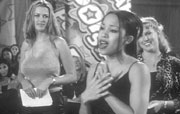KNIFE IN THE WATER, JOHN VANDERSLICE, KIND OF LIKE SPITTING, THE MENDOZA LINE
Crocodile, 441-5611, $8 9 p.m. Fri., March 22
IN NEW YORK CITY, the subways round corners and whine against their rails like fingernails on chalkboards. In San Diego, the waves crash endlessly— no matter what you do, you’ll never be able to switch off the sound of the ocean. Seattle is a symphony titled “Rain on Rooftops, With Occasional Thunder.” Austin echoes with wide-open spaces, loose drawls, and the rumble and crash of empty beer bottles in the back of flatbed pickup trucks.
Those loud sounds of New York spawned the Ramones and rap. San Diego pushes out a new crappy punk band about every three minutes, in incremental accordance with those waves. The world likes to oversimplify our own town’s contributions; they say “grunge” and call it a day, but we know better than that. Austin’s donations range from the Butthole Surfers to Willie Nelson—and more recently, Knife in the Water. Where you’re from matters as much, if not more, as where you’re going, and with Knife in the Water’s smooth, sliding swirls, the two are one and the same.
“I can’t imagine doing this anywhere else. It’s very much in our blood,” says Knife in the Water’s guitarist and lyricist, Aaron Blount.
“It’s one of my favorite things when I hear other bands,” Blount says about the insight that geography allows. “What I think great music comes from—it’s all related to space. It’s the same thing with writing and art as well. It’s kind of an inevitability about being grounded in it. Most of us are native, and we didn’t really have a choice.”
The inevitability that Blount is referring to is their unique sound: The inescapable drawl, the languid twang, and the spooky ghost-town echo of his band’s haunted, cinematic song- stories. It’s more than the pull of the pedal steel, and it’s not just Blount’s inflection, organist Laura Krouse’s gentle harmonies, the waltzlike tempos, the soft, leather-boot shuffling of the drums, or the Lee Hazelwood cover from their last full-length. It’s something far more ingrained and inherent; something dusty and old that simply could not come from anywhere other than the deep, dark, secretive heart of Texas. Or could it?
As much as we’d like to blame Texas, songs like “Promenade,” from 2000’s Red River (Overcoat), or “When Trouble Goes to Seed,” off the upcoming EP, Crosspross Bells (Peek-A-Boo), are colored by the same eerie needle- injected memories that inspired the Velvet Underground’s preconceived notions of all tomorrow’s parties, Nick Cave’s twisted murder ballads, and Spaceman Jason Pierce’s spaced-out hallucinations. A band’s geography informs a certain percentage of their sound, but the best music—the best art—transcends any setting. The best music bridges time and space, connecting the shared experiences of this life and documenting time like snapshots made of sound.








